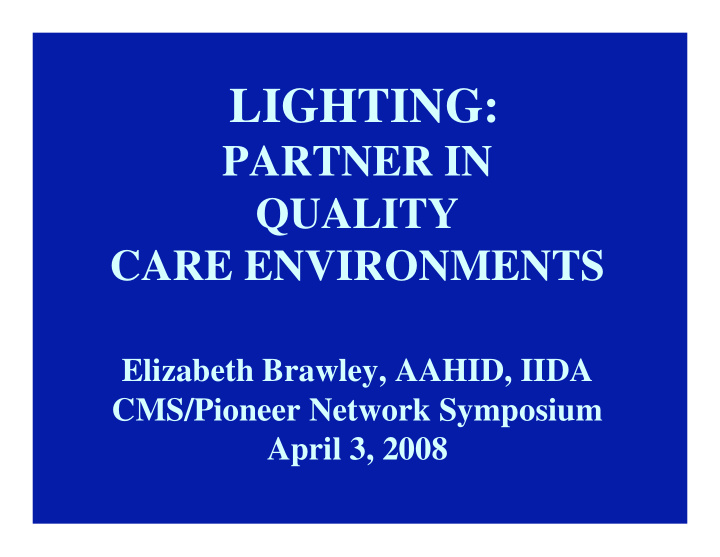



LIGHTING: PARTNER IN QUALITY CARE ENVIRONMENTS Elizabeth Brawley, AAHID, IIDA CMS/Pioneer Network Symposium April 3, 2008
Age Related Changes Arthritis • Hypertension • Hearing Impairment • Vision Impairment • Mobility Impairment • Depression • Diabetes • Osteoporosis •
Our Eyes Change As We Age
Normal Age-Related Vision Changes • Pupil is Smaller - • Lens Thickens - almost fixed in size Yellowish/Amber Color • Less light enters the eye • Difficulty Focusing • Difficult to Adjust to Changes in • Loss of Contrast Brightness Sensitivity
Changes to the Lens Lens of a 10 year old Lens of a 65 year old
VISION • Reduced Visual Acuity • Restricted Field of Vision • Sensitivity to Glare • Change in Depth Perception • Impaired Ability to Adapt to Changes in Light Levels • Contrast Sensitivity • Restricted Color Recognition
Eye Diseases are More Prevalent in Older Adults 1. Macular Degeneration - foremost cause of blindness over 60 2. Cataracts (50% individuals ages 65-75) 3. Glaucoma 4. Diabetic Retinopathy
Implications of Age-Related Vision Loss • Increase in falls • Limits mobility in unfamiliar areas • Limits independence
MOBILITY and FALLS • 1/3 people 65+ fall each year • Half of the falls are recurrent • 1 in 10 falls result in serious injury • 87% of fractures in the elderly are due to falls
Mobility: Risk Factors for Falls • Age • Cognitive loss • Vision changes • Incontinence • Environmental • Weakness and strength loss hazards • Balance • Medication • Fear of falling
Environmental Supports Encourage Mobility • Higher Light Levels • Control Glare • Strong Contrast • Handrails for Support
IMPROVE LIGHTNG • Higher Light Levels • Even Illumination • Eliminate Glare • Task Lighting • Balance Daylight and Electric Light • Combine Direct/Indirect Lighting • Provide Gradual Changes in Light Levels ANSI/IESNA RP-28-2007 Lighting and the Visual Environment for Senior Living
ENHANCE LIGHTING
Daylighting • More natural light • Large skylights • Larger windows • Need for both skylights and windows rather than windows alone
GARDENS AND OUTDOOR SPACES • Porches • Sunrooms • Greenhouses • Gardening • Walking & gathering spaces
Daylight Exposure • Maintains Circadian Rhythm • Promotes Better Sleep Quality • Promotes Vit. D Synthesis for Healthy Bones • Prevents Depression • Reduces Agitation
SLEEP DISORDERS • Experienced by 50% of those over 65 • 72% of nursing home residents are “poor sleepers” especially those with Alzheimer’s • Sedative and hypnotic medications are the common treatment • These medications are strongly linked to falls and hip fractures
Meaningful Activity
Exercise – Increases • Mobility • Balance • Social Activity • Exposure to Daylight
Lighting can and will make a greater difference in the success of a healthcare setting than any other single feature except for the healthcare itself. Design Innovations for Aging and Alzheimer’s
Recommend
More recommend